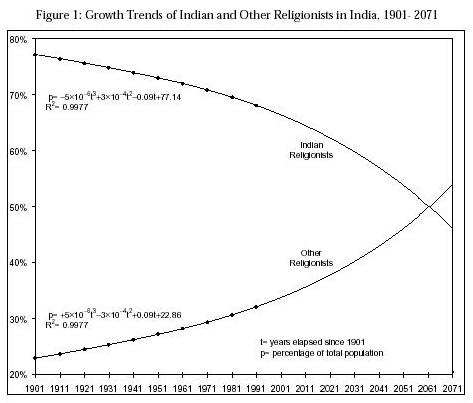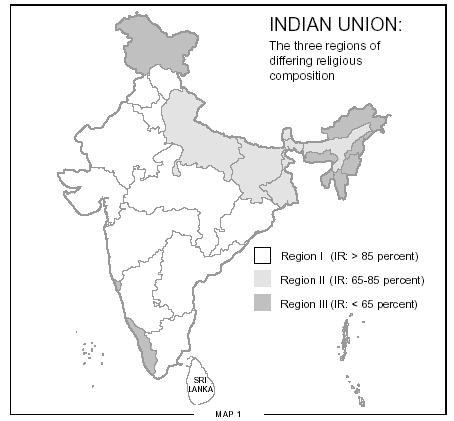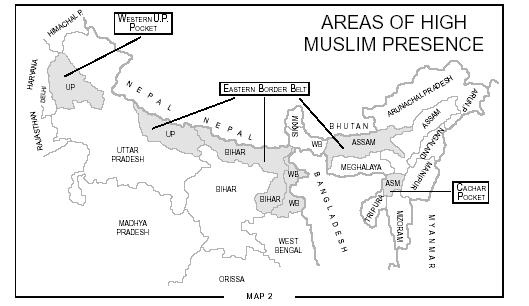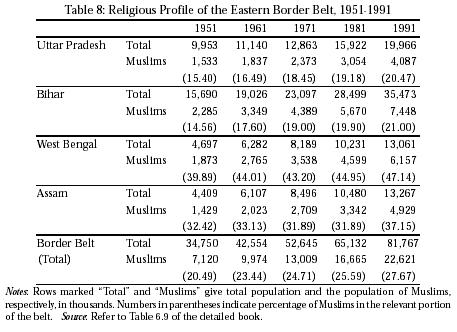State wise Composition
Projecting the Trends into the Future
Our analysis of the religious composition of the population of India provides us with 12 data points, spread over a period of 110 years from 1881-1991. The data for 1881 and 1891 are not strictly comparable with the rest, because the coverage and accuracy of these early censuses were considerably lower than of the later censuses. The remaining 10 data points, giving religious composition of Indian population from 1901-1991, provide a sufficiently long time-series to statistically project the trend into the near future.
In Figure 1, we attempt such a projection by obtaining the best possible fit for the available data points and letting the resulting trend-line extend further into future. The upper curve in the graph plots percentage of Indian Religionists as recorded in Table 7; the lower curve plots percentage of Other Religionists, obtained by subtracting the percentage of Indian Religionists from 100, or by adding the percentage of Muslims and Christians in Table 7.
The available data fits best to a polynomial equation of third order. As is obvious from Figure 1, the fit obtained is quite good; R2-value for the fit at 0.9977 is almost near 1. Projections based on this fit should therefore be fairly reliable.
The best-fit curve for the percentage of Indian Religionists is smoothly moving down from about 77 percent in 1901 to about 68 percent in 1991, the curve for the percentage of Other Religionists correspondingly keeps moving up, and the two curves projected into the future intersect at the 50 percent mark just before 2061. Thus, if the trends of the last hundred years continue to persist in the future, then Indian Religionists shall become a minority in India in the near future.
This is an entirely statistical conclusion. It follows from the best possible fit of the available data of the last hundred years; it involves no assumptions. However, we can make an assessment of the plausibility of this conclusion by analysing the United Nations projections of the population of India. The latest United Nations estimates published in World Population Prospects, 2000 Revision, place the medium estimates for the population of Indian Union, Pakistan and Bangladesh in 2050 at 1572, 344 and 265 millions, respectively. These estimates are based on detailed assumptions about various human development factors like the spread of literacy and acceptance of family planning. Following the current trends, we may assume that in 2050 Indian Religionists shall have a share of 80 percent in the population of Indian Union, 1.5 percent in that of Pakistan, and 5 percent in Bangladesh. Then, in 2050, the share of Indian Religionists in the population of India turns out to be 58.5 percent.

For Indian Religionists to have a share of 80 percent in the population of Indian Union, 1.5 percent in that of Pakistan and 5 percent in Bangladesh towards the middle of the twenty-first century is a highly optimistic expectation. Their share in the population of Pakistan is already near this figure; in Bangladesh, their share has been declining rapidly and it is certainly likely to go below 5 percent in the next fifty years. In Indian Union also, the share of Indian Religionists in the population has been declining steadily. Their share is likely to fall even below 80 percent by 2050. If we take the share of Indian Religionists in the population of Indian Union at that stage to be 75 percent, and apply it to the United Nations estimates for the total population, then the share of Indian Religionists in the population of India comes down to about 55 percent in 2050.
RELIGIOUS COMPOSITION OF DIFFERENT REGIONS OF INDIAN UNION
Indian Religionists have lost heavily in their share of the population of India as a whole. The decline in their proportion within Indian Union has not been nearly as high, though they have indeed lost about 2 percentage points off their share since Independence and Partition. Detailed state-wise and district-wise data, however, reveals that the loss in the share of Indian Religionists has been fairly steep in certain geographically well-defined pockets of the country, while in most parts they have continued to hold sway.
In the Appendix Table II, we present detailed data on the religious composition of the States and Union Territories of the Indian Union for the period 1901-1991. Looking at the figures in this Table, it is possible to discern three broad regions of Indian Union with distinct religious profiles.
Region I: Where Indian Religionists Dominate
A very large part of Indian Union (see Map 1), comprising almost all of the northwestern, western, central and southern states, has seen little decline in the proportion of Indian Religionists. Indian Religionists have an overwhelming dominance in this vast region that includes almost two-thirds of the geographical area and about 57 percent of the population in 1991. They form more than 91 percent of the population of the region; their proportion has declined only marginally since 1951. Within the region there are only a few small pockets, where Christians or Muslims have any significant presence.
Indian Religionists constitute a preponderant majority in this region. They form more than 85 percent of the population in every state of this vast region, extending from Punjab in the north to Tamil Nadu in the south. Proportion of Indian Religionists in the northwestern states of Punjab, Haryana and Himachal Pradesh and in the central states of Madhya Pradesh and Orissa is around or above 95 percent. In Delhi, in the western states of Rajasthan and Gujarat and in the southern states of Maharashtra, Andhra Pradesh and Tamil Nadu, they form nearly 90 percent of the population. In Karnataka their share is above 86 percent. Muslims and Christians constitute small minorities in most of the districts in this vast region, except in a few well-defined pockets. The most significant of these is a belt of relatively high Muslim presence centred on Aurangabad district of Maharashtra and Hyderabad city district of Andhra Pradesh. Between these two centres, and stretching somewhat north and south of these, this belt encompasses East Nimar district of Madhya Pradesh, several districts in the central part of Maharashtra, northern districts of Karnataka and northwestern districts of Andhra Pradesh. In the whole of this belt, Muslims form a significant presence; their share is more than 12 percent in every district, and in some of the districts it is considerably higher.
In some of the scattered pockets of high Muslim or Christian influence in this region, there has been a considerable rise of these religionists during the last four decades. Thus, the share of Muslims has shown abnormally high rise in Delhi; in Chamba district of Himachal Pradesh; Sangrur of Punjab, Gurgaon of Haryana; neighbouring Alwar district of Rajasthan; Thane, Nashik, Aurangabad and Akola districts of Maharashtra; Hyderabad and Nizamabad districts of Andhra Pradesh; and Uttar Kannad, Dakshin Kannad and Kodagu districts of Karnataka. Christians have registered a high growth in the Dangs district of Gujarat, Sundargarh and Phulbani districts of Orissa and Kanniyakumari of Tamil Nadu.

Notwithstanding this presence and growth of other religionists in some pockets, Indian Religionists have maintained their share in the population more or less intact in the whole of this region, consisting of about two-thirds of the geographical area and three-fifths of the population of Indian Union in 1991.
Region II: Where Indian Religionists are under Pressure
In the heartland and eastern regions of Indian Union, comprising Uttar Pradesh, Bihar, West Bengal and Assam (See Map 1) Indian Religionists are under great pressure. This region encompasses the most fertile lands of India and accommodates about 37 percent of the population in 1991 on about 19 percent of the geographic area of Indian Union. In this region as a whole, Indian Religionists have a share of only about 80 percent in the population; and, they have suffered a decline of about 4 percentage points in their share in the four decades between 1951 and 1991. The rest of the population is formed mainly of Muslims, who have a share of nearly 19 percent in the population. Looking at the individual states in the region, we find that the share of Indian Religionists keeps progressively declining and that of Muslims rising as we move from Uttar Pradesh to Bihar, West Bengal and Assam.
Christians in this region are few; they have a share of less than 1 percent in the population. Christians have a significant presence only in two limited pockets: One, the pocket formed by the undivided Ranchi district of Bihar and neighbouring districts of Raigarh in Madhya Pradesh and Sundargarh in Orissa; and two, the North Cachar Hills district of Assam.
Muslims form a significant presence in the whole of this region and there are several districts, especially in West Bengal and Assam, where they form a preponderant majority. But their presence is especially high in a northern border belt (see Map 2) that starts from Bahraich district of eastern Uttar Pradesh and moves through Gonda, Basti, Gorakhpur and Deoria districts of the state; to Champaran, Muzaffarpur, Darbhanga, Saharsa, Purnia and Santhal Pargana districts of Bihar; West Dinajpur, Maldah, Birbhum and Murshidabad districts of West Bengal; and Goalpara, Kamrup, Darrang and Nagaon districts of Assam.

As shown in Table 8, Muslims form about 28 percent of the population of this border belt; their growth here has been high enough to add almost 7 percentage points to their share of the population in the four decades since Partition. The districts we have counted above are undivided districts, as they existed in 1971. Since then, the districts have been divided several times. The proportion of Muslims in the new smaller border districts is even higher; available data indicates that several blocks and police-station areas along the border have recorded a very high presence and growth of Muslims.

In addition to the northern border belt, Muslims also have a high and fast-growing presence in an interior region centred on Muzaffarnagar district of western Uttar Pradesh, in the region around Calcutta in West Bengal, and in Cachar district of Assam. Uttar Pradesh, Bihar, West Bengal and Assam, and especially the border areas of these states and a few interior pockets within them, thus constitute a region of high Muslim presence and growth. The share of Indian Religionists in this region is under great stress and is likely to remain so in the future; Indian Religionists have already turned into a minority in several districts of the region.
Region III: Where Indian Religionists are turning a Minority
Finally, there is a third region of Indian Union (see Map 1) comprising the extreme border areas – including Jammu and Kashmir in the north, Goa and Kerala in the West, Lakshadweep and Nicobar Islands off the Indian coast, and the states of the northeast – where Indian Religionists do not have a dominating presence. Indian Religionists form only about a third of the population of Jammu and Kashmir; their presence in the valley districts of the state is insignificant. Their share in the population of the state as a whole has indeed improved slightly after Partition. The valley, however, has become almost entirely Muslim, while the Jammu region has become more predominantly Indian Religionist in the period following 1951. In Goa, Indian Religionists constitute about two-thirds of the population; of the rest about 30 percent are Christians and 5 percent Muslims. This is one of the rare states, where Indian Religionists have considerably improved their share; the state seems likely to acquire a religious profile similar to the neighbouring states of Karnataka and Maharashtra in the near future.
Kerala
In Kerala, Indian Religionists have been losing ground throughout the twentieth century. They have a share of 57 percent in the population in 1991; this is about 12 percentage points less than their share in 1901. They have lost about 6 percentage points to Christians and about the same to Muslims; the gains of Christians occurred largely during the pre-Partition period of 1901-1941 and those of Muslims during the post-Partition period of 1951-1991. This loss of about 12 percentage points in the course of the twentieth century has occurred on top of the substantial losses that Indian Religionists in Kerala suffered due to large-scale conversions to Islam during the later part of eighteenth century and to Christianity during the nineteenth. Thus in the course of the last three centuries, Indian Religionists have comprehensively lost their dominance in this coastal state.
Lakshadweep
Lakshadweep Islands off the Kerala coast have been predominantly Muslim throughout the twentieth century. The share of Muslims in the population has marginally declined from near 100 percent in 1901 to around 94 percent in 1991.
Andaman & Nicobar Islands
In the Union Territory of Andaman & Nicobar Islands, which is a chain of Islands far away in the Bay of Bengal, the share of Indian Religionists has dropped from about 81 percent in 1901 to about 68 percent in 1991. This is in spite of the fact that the Indian Religionists registered a marginal rise in their share, from about 72.5 percent in 1901 to about 75 percent in 1991, in the Andamans Islands district of the Territory. This rise has been offset by the precipitous decline in the share of Indian Religionists in the Nicobar Islands district of the Territory in the decades following Independence and Partition. Their proportion in the district declined from about 98 percent in 1941 to about 27.5 percent in 1961, and has remained around that figure since then. The Nicobar Islands, forming the southernmost tip of India, have turned almost 70 percent Christian in the recent past.
Northeastern States (excluding Assam)
The most dramatic story of the twentieth century, however, is that of the northeastern states, not including Assam which we have already discussed above. These states – that form a mountainous wall around the Brahmaputra valley and thus offer a protective cover along the eastern borders of India with Tibet, China, Myanmar and Bangladesh – are experiencing an intense movement of conversion towards Christianity. In several of these states, entire populations have been converted in quick spurts. One such major spurt took place during the Independence decade of 1941-1951, and involved all states of the region, except Arunachal Pradesh and Tripura.
In Nagaland, this single spurt took the share of Christians in the population of the state to nearly 54 percent from almost zero in 1941 and less than 13 percent in 1931, the year for which the census recorded the highest proportion of Christians for the pre-Independence period in all these states. In 1991, Christians in the state constitute about 88 percent of the population and Indian Religionists that are left in the state are mostly confined to Kohima district.
In Mizoram, conversion to Christianity began somewhat earlier, around 1921, but like in Nagaland, there was a major rise in Christian share during the Independence decade of 1941- 1951; more than 90 percent of the population was converted to Christianity at the end of the decade. Their proportion was recorded to be nearly zero in 1941 and 48 percent in 1931. In 1991, Christians constitute 86 percent of the population of the state; of the remaining Indian Religionists in the state a little more than half are Buddhists, who are concentrated mainly in the sparsely populated southern districts.
The Christian spurt of 1941-1951 had a relatively milder impact on Meghalaya; only about a quarter of the population of the state got Christianised at the end of the decade. Conversion efforts have proceeded steadily since then. In 1991, share of Christians in the population has risen to about 65 percent; their share is much higher in East Garo Hills and West Khasi Hills forming the central part of the state.
The impact of the 1941-1951 phenomenon of large-scale Christianisation in the northeast was even less pronounced in Manipur. In 1951, only about 12 percent of the population of Manipur was Christianised. By 1991, the proportion of Christians has risen to 34 percent; but the outer districts of the state have been almost fully Christianised. Indian Religionists in the state are concentrated in the densely populated inner three components, Imphal, Bishnupur and Thoubal, of the undivided Manipur Central district.
Arunachal Pradesh, geographically the largest state of the region, has begun experiencing Christianisation only during the last two decades. In these two decades, Christian share in the population has risen to more than 10 percent starting from an almost negligible presence, and in Lower Subansiri and Tirap districts Christians already form around a fifth of the population.
Tripura alone amongst these six states has resisted the trend; presence of Indian Religionists in the state has significantly increased during the decade of 1961-71. But Tripura is not a mountainous border state like the other five. The populations of the northeatern states of India bordering on Tibet, China and Myanmar are fast converting away from their Indian Religionist moorings; much of this conversion has occurred in the last few decades, and the phenomenon is spreading to the areas that are not yet converted.
We have compiled religion-wise population of all these states together in Table 9 below. In 1901, Indian Religionists formed more than 90 percent of the population of these states, while Christians formed less than 2 percent. In 1991 the proportion of Indian Religionists is reduced to about 55 percent, while that of Christians has risen to nearly 40 percent. Most of this change has occurred during the period following Indepen dence; in 1941, Indian Religionists still formed nearly 90 percent of the population, and even in 1931, the proportion of Indian Religionists in the population was more than 80 percent; of the rest only about 10 percent were Christians.

Share of Indian Religionists in the population of the region today seems somewhat respectable because of the persistence of Indian Religionists in Tripura and the central districts of Manipur; these areas were ruled by avowedly Vaishnava states for several centuries. In other parts of the region, especially in Nagaland, Mizoram, outer districts of Manipur and much of Meghalaya, Indian Religionists have been reduced to an insignificant minority.
To sum up our discussion so far, Indian Religionists have suffered a loss of more than 11 percentage points between 1881 and 1991 in India as a whole, which constitutes a drastic change in the religious profile of a compact geographical region like India. It is, however, even more significant that the losses have been highly pronounced in border regions, especially after Independence. This is leading to the formation of border pockets, where Indian Religionists are in a minority or nearly so. Existence of such distinct pockets formed the demographic basis of Partition of the country in 1947. A similar pocket of high Muslim influence seems to be now developing in the northern border belt covering the states of Uttar Pradesh, Bihar, West Bengal and Assam. And, a border pocket of even more intense Christian influence has developed in the northeastern states. Nicobar Islands district on the extreme southern tip of the country has been Christianised. And, Indian Religionists have lost sway in the western coastal state of Kerala. Most of these changes have taken place in the short span of time since Independence and Partition.